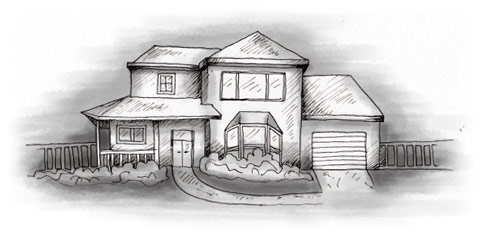To limit these losses, the financial institutions are looking for new homebuyers for those bad mortgage loans. But this is a very difficult task, because many people in Spain are offering real estate properties and only few have the financial capacity to buy. The financial institutions want to get rid off their huge real estate stocks that “produce” nothing and which are no longer worth what they once were.
Hardball negotiating professionals take advantage of this situation and acquire the Spanish real estate properties in court auctions with a discount of up to almost 50%. In some cases, the discounts are even bigger.
Hardball negotiators use atypical buying strategies, e.g.:
- Some of the investors buy the mortgage loan at a reasonable price and later on, eventually, apply themselves for the court auction. If there is no offer in the court auction, the investor can swap his mortgage loan for ownership of the real estate property.
- Often, the auctioned real estate properties are allocated to the financial institution itself. The investor has the opportunity to buy this allocation title at an attractive price.
- Another alternative is to buy the real estate property before the auction is held. The negotiation power of the owner of the real estate property is low. The financial institution will intervene to make an attractive price.
No matter which option the investor chooses, he must ensure in each case that the real estate property he intends to acquire is a prime property. In addition to that, the investor must absolutely check the liability- situation of the real estate property for other debts.
To better understand the Spain court auction system of real estate properties, I will illustrate it with some examples. The examples are fictitious and are not exhaustive regarding the acquisition options. A court auction depends very much on the concrete situation, intentions of the bank and the owners, on the offers presented by others and so on. A liability for the accuracy of this article is excluded by the author.
CASE 1 (TYPICAL ALLOCATION OF THE PROPERTY IN A COURT AUCTION):
A prime Spanish property with a current market value of € 120,000 has several real burdens:
- A mortgage loan of a financial institution amounting to € 60,000.
- Second-creditor in the amount of € 25,000 and
- Third-creditor in the amount of € 15,000.
The prime property is not rented to anybody.
The second creditor claiming the amount of € 25,000 initiates the court auction of the prime property.
At what price does the court offer this primer property in the court auction?
The price is based on the market value minus the real burdens of previous creditors.
In the above example, this means that the real estate property is offered at € 60,000 (=€ 120.000 market value - € 60,000 mortgage because this is the previous real burden).
What price can the investor offer?
The investor can bid 50% or more of the court auction price.
Exceptionally, the investor can offer 50% or less as long as his offer covers the amount of the claim that is being enforced in the court auction plus all enforcement costs plus interests. The Spanish courts are applying a prudent 30% of the claim which is being enforced. This 30% is thought to cover enforcements costs plus interests.
In our example, the claim being enforced amounts to € 25,000. If the court applies 30% for enforcement costs + interests (=€ 7.500), the minimum offer can be € 32.500.
In this case, the investor will choose to offer at barely more than 50% because it will be more convenient for him. In this option he can offer € 30,600.
In such a case, the owner of the property and the executing creditor are allowed to present counter offers within 10 days and 5 respectively. If they cannot produce counteroffers, the real estate property will be allocated to the investor for € 30,600.
Is this a good deal? Let us check it in more detail:
Liabilities of the auctioned real estate property for other burdens
The auctioned real estate property is liable for all real burdens previous to the one which initiated the auction. The auctioned real estate property is not liable for subsequent burdens.
In addition, the auctioned real estate property is liable for some specially protected claims, eg homeowner debt, IBI tax (taxes for real estate properties) for the current and last year, wage arrears for workers, tax debts, liabilities etc. with social security. Thus, it is of utmost importance to check the liabilities of the real estate property before placing any bid for it in the court auction.
In addition, the investor has to check if the property is rented or not. If so, the investor must check if and, eventually, how long the third person is entitled to live in the rented real estate property.
In our above described example, the investor of the prime property ends up with a mortgage debt of € 60,000 which he must pay. However, his newly acquired property is not liable for the debt of the third-creditor (€ 15,000).
RESULT IN CASE 1: The real purchase price thus amounts to a total of € 90,600 (= € 30,600 auction price + 60,000 € for the mortgage).
Which are the alternative strategies to acquire the prime property at much less price?
CASE 2 (TYPICAL CASE OF A COURT OF AUCTION: THE MORTGAGE BANK HAS APPLIED FOR THE COURT AUCTION).
Suppose, not the second creditor, but the financial institution (= mortgage loan creditor) initiated the court auction of the real estate property. This is the typical situation in Spain.
The first noteworthy particularity is that the Escritura de Hipoteca (the deed of the mortgage loan) probably already determines a specific court auction price for property, which can be significantly above the current market value. This price is the starting point in the court auction. In our example, let us suppose that the mortgage deed determines the auction price at 200.000 €.
Normally, the minimum bid must be almost 50% or more. This means that our investor would have to offer more than 100,000 €.
Exceptionally, however, our investor can make a bid of 50% or less than 50% if his bid covers the executing claim + interest + costs. Interests and costs are, generally, estimated at a 30% of the claim that is being enforced. In our case number 2 this means that the 30% amounts to € 18,000.
The minimum bid amounts to € 78,000 = 60,000 € (mortgage claim) + € 18,000 (for costs plus interests):
RESULT IN CASE 2: Since there is no higher bid the investor acquires the property at € 78,000.
CASE 3: THE INVESTOR BUYS THE ALLOCATION TITLE FROM THE MORTGAGE BANK.
Like Case 2, but nobody in the court auction submits a bid for the property. In this case, the financial institution may request to swap the mortgage loan for the ownership of the property.
The property is not liable for the subsequent real burdens. The subsequent real burdens as well as the mortgage extinguish.
RESULT IN CASE 3: The investor can buy this allocation title from the financial institution. The price depends on his negotiation skills. In our case example, this shall be € 60,000 to cover the mortgage.
CASE 4 (ACQUISITION OF MORTGAGE DEBT + SUBSEQUENT SALE OF PROPERTY IN A COURT AUCTION).
Before opening the court auction, the investor can buy the mortgage loan from the mortgage bank. Once the investor has acquired the mortgage he can apply for the court auction if the debtor does not pay his mortgage debt.
Let us suppose that the investor in our example buys the mortgage from the financial institution at € 40,000. In addition to that let us suppose the debtor does not pay. Thus, our investor applies for the court auction.
In the court auction there may be some bidder who offers the minimum, this means: € 60,000 plus 30% for interests and costs.
RESULT IN CASE 4: The gross profit margin for the investor-buyer thus amounts to € 20,000 ( = € 60,000 mortgage debt - € 40,000 purchase price of the mortgage debt).
CASE 5: (ACQUISITION OF MORTGAGE DEBT + SWAPPING THE MORTGAGE FOR THE OWNERSHIP).
As Case 4, this means: the investor is the creditor of the mortgage loan. The investor initiates the court auction, but nobody bids.
At his request, the real estate property will be allocated to the investor. Mortgage and all other subsequent real burdens extinguish.
RESULT IN CASE 5: The investor acquires the prime property for € 40,000 (= purchase price for the mortgage). The subsequent charges extinguish because they are subordinated.
What taxes and other costs must be considered when you buy a real estate property in spanish court auctions?
In general, the investor pays 7% impuestos sobre Transmisiones (tax transfers of assets). This tax may vary regionally.
The 7% will be applied to the allocation price, not the initial auction price. If the property is liable for previous real burdens, then these must be added to the allocation price. Subsequent real burdens are not considered.
Case 1: 7% of € 90,600 = € 6,342.
Case 2: 7% of € 78,000 = € 5,460.
Case 3: 7% of € 60,000 = € 4,200.
Case 5: 7% of € 40,000 = € 2,800.
Case 4 is not included here because the investor does not acquire the property. Both, in case number 4 and in case number 5 additional costs must be included: notary fees because the mortgage is being acquired.
Furthermore, the registration and cancellation costs of the Registro de la Propiedad (Official Registry of Real Estate Properties) for the titles and real burdens must be added.
What are the requirements for bidding in the spain court auctions of real estates?
The only requirement is to make a 30% security deposit or offer a 30% bank guarantee on the court auction price. This will be returned once somebody else acquires the property at a higher bid.
If the investor does not want to bid in the court auction, if he only wants to buy the allocation title of one of the bidders, then he does not need to make the previous 30% security deposit.
By Daniel Talavera of The Spanish Brick


